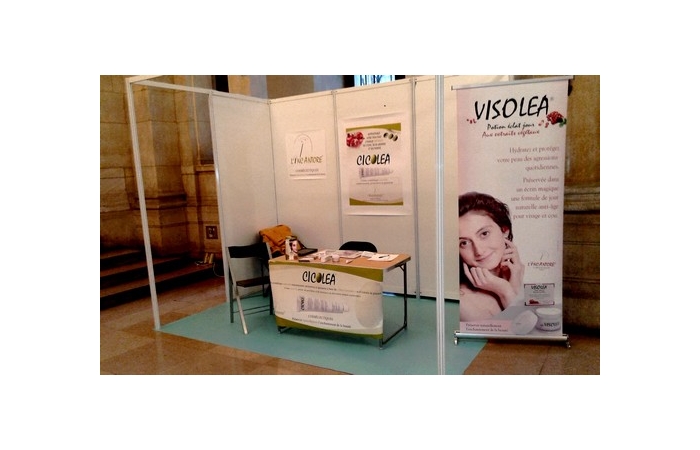The Italian affiliate of l’Incanto, l’Incanto Italia, participates in a research project financed by the European Community for the identification of active ingredients extracted from the plants which develop in the South of Italy. The research began its works on numerous present plant extracts in Calabria, very interesting bioactive components from the cosmetic, nutritional but also environmental point of view.
Our researcher as well as the researchers of the Universities of Salerno and Reggio Calabria highlighted the high antioxidizing activity of the red onion of Tropea on the skin, usually considered as a waste, by determining exactly its chemical composition constituted mainly by flavonoids which is a fundamental prerequisite for a more sustainable and productive use in cosmetic, pharmaceutical and nutraceutical formulations.
Also, if the quality, the aroma and the taste of the roots of Calabrian licorice are world-famous, the air parts of the licorice usually considered as wastes were analyzed and turn out to be surprisingly a source of bioactive ingredients for the plant itself and for us because of the presence of numerous components belonging to 2 major classes of polyphenols. From an ecological perspective, the flavonoids in the outer leaves part represent a more efficient plant protection against insects.
Given the antimicrobial and antiinflammatory properties of the main components of the air parts of the licorice, it is obvious that these “wastes” represent a source of potential raw material to recover health-promoting ingredients for cosmetic, nutraceutical and food sectors. Further studies are underway to assess their applications.
The results of these first researches were presented to the following Congresses:
Congrès Mondial annuel de la Société Italo-Latino-Américaine de Ethnomédecine, Alimentation et Santé (SILAE) à Milazzo (Sicile) : World Ethnomedicine Summit du 9 au 13 Septembre 2018

And
Chimali – XII ° Italian Food Chemistry Congress
Camerino (ITALY) 24-27 SEPTEMBRE 2018

CHIMALI – XII Italian Food Chemistry Congress
Camerino, September 24-27 2018
N’oublions pas le principe de l’Ïncantore :
Rechercher les ingrédients dans la Nature pour préserver naturellement l’enchantement de la beauté.
RESUME DES ARTICLES
Tropea Onion skin: from a waste product to new valuable matrix for bioactivity
Rita Celano1, Teresa Docimo2, Anna Lisa Piccinelli1, Luca Campone1,4, Claudio Cannistrà3, Rosa Di Sanzo4, Sonia Carabetta4 Luca Rastrelli1, Mariateresa Russo5
1Department of Pharmacy, University of Salerno; 2L’incanto Sarl, Catanzaro; 3 Hôpital Bichat – Claude-Bernard, Paris, Francia; 4 Food Chemistry, Authentication, Safety and Sensoromic Laboratory – Università Mediterranea di Reggio Calabria
Introduction
The red onion from Tropea is known for its sweetly taste, which is mainly due to the flavonoids and the alk(en)yl cysteine sulphoxides (ACSOs) compounds. The unique red onion envelope usually considered a waste product, represent a valuable source of biomolecules therefore accurate chemical characterization of this matrix is a fundamental prerequisite for a more sustainable and productive use in pharmaceutical, cosmetical and nutraceutical formulations.
Methods
The outer layers of red skin onion bulbs were collected, dried and finely powdered. Exhaustive extraction of dried materials was performed by ultrasound-assisted extraction (UAE) with aqueous ethanol (70% v/v). A UHPLC-HRMS/MS method was developed and then applied to analyze the onion-skin extract.
Results
The chemical composition of onion-skin extract was determined by UHPLC-DAD-HRMS analysis. Metabolite assignments were made comparing UV/Vis, HRMS and MS/MS spectra with reference standards when available, or with chemo-taxonomic data reported in the literature and databases. The main compounds detected in the extract belonging to two major classes of secondary metabolites: anthocyanins and flavonols. The main flavonols found in this onion type were quercetin and quercetin glucosides, isorhamnetin glucosides, kaempferol glucoside, and, among anthocyanins, cyaniding glucosides. This extract has shown a high antioxidant activity. The activity antioxidant was measured by DPPH, ABTS and ORAC assays.
Conclusions
The obtained results have shown that the onion-skins are a promising and cheap source of bioactive compounds with high antioxidant activity. Furthermore, their use as a substitute for synthetic antioxidants, in addition to increasing food security, would contribute greatly to increase their added value.
Unravelling metabolic plasticity of Glycyrrhiza glabra leaves DOP calabrese by chemical profiling
Rita Celano1, Teresa Docimo2, Anna Lisa Piccinelli1, Claudio Cannistrà3, Antonio Massarotto4, Salvatore Fuda5, Luca Rastrelli1, Mariateresa Russo5
1Department of Pharmacy, University of Salerno;
2 L’incanto Sarl, Catanzaro; 3 Hôpital Bichat – Claude-Bernard, Paris, Francia; 4 Naturemed srl, Cosenza; 5 Food Chemistry, Authentication, Safety and Sensoromic Laboratory – Università Mediterranea di Reggio Calabria
Introduction
Quality, aroma and flavor of Calabrian licorice roots are worldwide recognized, although it’s worth noting that aerial part of this plant , usually treated as waste product, represent a surprisingly source of bioactive metabolites. Indeed distribution of metabolites depicts a peculiar biosynthetic and developmental plasticity. In this work we report the chemical profiling of surface and inner leaf content.
Methods
Licorice aerial parts were harvested in pre flowering and flowering time. Leaves, panicles and flowers in flowering periods were collected dried and were ultrasound extracted with EtOH /H2O 70% three times. Vacuum dried samples were reconstituted in MeOH/H20 1:1 for further qualitative analysis by UHPLC system. Exudates from outer licorice leaves was performed by ETOH brief immersion for 10 sec and vacuum dried , samples were analized as above.
Results / Discussion / Conclusion
UHPLC-ESI-HRMS analyses were performed in negative and positive ionization mode to obtain complementary information useful for characterizing the extracts of leaves, exudates, panicles and flowers in flowering periods. Metabolite assignments were made comparing UV/Vis, HRMS and MS/MS spectra with reference standards when available, or with chemo-taxonomic data reported in the literature and databases. The UHPLC-DAD-HRMSn analysis has allowed to identify 46 compounds belonging to two major classes of secondary metabolites: dihydrostilbenes and flavonoids. The dihydrostilbenes have the same central scaffold with different functional groups on the two aromatic rings: hydroxyl, methoxy and prenyl units. The flavonoids are glycosilated derivatives of quercetin, kaempferol, myricetin and naringenin. All extracts showed UHPLC-UV profiles qualitatively comparable except for exudate, which showed dihydrostilbenes exclusively.
Licorice aerial parts are a very promising reservoir of bioactive molecules for plant itself and humans. From an ecological perspective prenilated flavonoids in the outer leaves part represent a more efficient plant protection against insects. These molecules along with inner leaf content of glycosilated flavonoids augment flavonoid bioactivity by increasing membrane affinity and improving the interaction with target proteins.
Chemical profiling of Glycyrrhiza glabra aerial parts, a waste product of PDO
‘‘Licorice of Calabria’’
Rita Celano1, Teresa Docimo2, Anna Lisa Piccinelli1, Claudio Cannistrà3, Antonio Massarotto4, Salvatore Fuda5, Luca Rastrelli1, Mariateresa Russo5
1Department of Pharmacy, University of Salerno; 2 L’incanto Sarl, Catanzaro; 3 Hôpital Bichat Claude Bernard, Paris, Francia; 4 Naturemed srl, Cosenza; 5 Food Chemistry, Authentication, Safety andSensoromic Laboratory – Università Mediterranea di Reggio Calabria
Introduction
Glycyrrhiza glabra aerial parts are a huge amount of discarded material produced during the cultivation and harvest of PDO ‘‘Licorice of Calabria’’ roots. This waste product represents a potential source of functional and health-promoting ingredients. The chemical profiles of exudates, leaves, panicles and flowers were determined by UHPLC-HRMS to estimate their nutraceutical potential.
Methods
G. glabra aerial parts were harvested in pre-flowering and flowering time from three PDO cultivations in Calabria. Exhaustive extraction of dried materials was performed by ultrasound-assisted extraction (UAE) with aqueous ethanol (70% v/v). Exudates were recovered by immersion of leaves in ethanol (10 sec). A UHPLC-HRMS/MS method was developed and then applied to analyze the aerial part extracts.
Results
Negative and positive UHPLC-HRMS analyses, combined with HRMS/MS spectra, chemo-taxonomic data and databases, allowed the full characterization of the metabolites of Calabrian G. glabra leaf exudate, leaf, panicle and flowers. 46 phenolic compounds were identified in aerial parts belonging to two major secondary metabolite classes: dihydrostilbenes and flavonoids. Dihydrostilbenes have the same central scaffold with different functional groups on the aromatic rings (methoxy and prenyl units). Identified flavonoids are flavanones (naringenin an pinocembrin) and their prenylated derivatives, C- and O-glycosilated flavones and flavonols. Dihydrostilbenes, pinocembrin and prenylated flavanones are the most abundant bioactive compounds of aerial parts and they represent the distinctive metabolites of leaf exudates. Instead, glycosylated flavonoids are present in inner leaves and flowers.
Conclusions
UHPLC-HRMS profiling prove that G. glabra aerial parts are a suitable and rich source of bioactive compounds. Their main compounds have well known antimicrobic and antinflammatory properties and it is evident that these wastes represent a potential raw material to recover health-promoting ingredients for food, cosmetic and nutraceutical sectors. Further studies are in progress to evaluate their potential applications.



